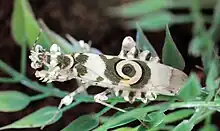| Pseudocreobotra | |
|---|---|
 | |
| P. wahlbergi adult | |
 | |
| P. wahlbergi nymph | |
| Scientific classification | |
| Domain: | Eukaryota |
| Kingdom: | Animalia |
| Phylum: | Arthropoda |
| Class: | Insecta |
| Order: | Mantodea |
| Family: | Hymenopodidae |
| Subfamily: | Hymenopodinae |
| Tribe: | Hymenopodini |
| Subtribe: | Pseudocreobotrina |
| Genus: | Pseudocreobotra Saussure, 1870 |
| Synonyms | |
| |
Pseudocreobotra is a genus of Sub-Saharan flower mantises. They are visually similar to Creobroter species of Asia,[1] but belong to different subfamilies. Their forewings have prominent spiralled eyespots, which are flashed in a silent deimatic display, to startle would-be predators. The nymphs however, expand the raised abdomen in response to threats, to reveal a single dorsal eyespot.[2] The species are easily reared in captivity.
Species
The species include:[3]
- Pseudocreobotra amarae Rehn, 1901
- Pseudocreobotra ocellata Beauvois, 1805
- Pseudocreobotra wahlbergi Stål, 1871
See also
References
- ↑ Yager, D.D. (April 1996). "Serially homologous ears perform frequency range fractionation in the praying mantis, Creobroter (Mantodea, Hymenopodidae)". Journal of Comparative Physiology A. 178 (4): 463–475. doi:10.1007/BF00190177. PMID 8847662. S2CID 1360448.
- ↑ Picker, Mike; et al. (2004). Field Guide to Insects of South Africa. Cape Town: Struik Publishers. pp. 60–61. ISBN 978-1-77007-061-5.
- ↑ Ehrmann, Reinhard (2002). Mantodea: Gottesanbeterinnen der Welt. Natur und Tier, Münster. pp. 291–292.
This article is issued from Wikipedia. The text is licensed under Creative Commons - Attribution - Sharealike. Additional terms may apply for the media files.